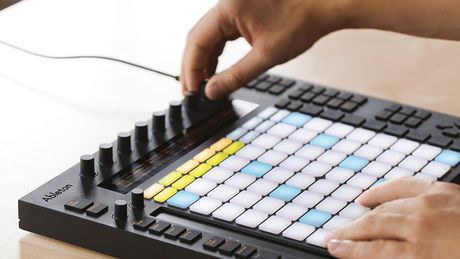

The original APC40 was a huge hit upon its initial release five years ago, and the new MkII version slims its footprint and physical depth down considerably, and drops the price (although some still prefer the more ‘premium’ build quality and alternative ergonomics of the original, it must be said). £290/$399 (APC40 MkII) and £180 (APC20) Akai APC40 MkII and APC20Īs well as handling the engineering and construction side of Ableton Push, the mighty Akai also has a selection of Live controllers of its own.

Read Ableton Push review Prev of 10 Next Prev of 10 Next Library browsing, step sequencing, scale mode and device control are the highlights in a long list of things that make it near-essential.

More of an ‘instrument’ than a mix controller, Push integrates with Live to an extraordinary extent. The eight touch-sensitive rotary encoders (the ninth being the master volume knob) and their accompanying dual displays are used for library browsing, mix adjustment and control of Live’s internal devices (third-party plugins have to be bundled into Instrument and Audio Effect Racks and assigned to Macros, annoyingly), while the many buttons give access to all of Live’s main functions. The useful Scale mode lights up the pads that align with the notes in your chosen key and scale, and you can even apply automation within step sequences for rhythmic parameter changes. Push centres on an 8x8 grid of RGB backlit pads that are used for real-time note input, step sequencing, clip launching and more. Ableton’s own controller, built in conjunction with Akai, is sleek, sexy and creatively inspirational. Here, then, is our guide to the best hardware and iOS Live controllers that money can currently buy.
#Ableton live controller software
By giving manufacturers and developers easy access to the software tools required to build such layouts, Ableton has rather cleverly facilitated its own sub-category of the MIDI controller market. The main reason for the 21st century’s most ubiquitous production platform being so uniquely served in this area is its groundbreaking Session View, constituting a readily-controllable environment for live performance that requires a very particular but conceptually uncomplicated type of hardware layout to fully interface with - the proverbial ‘clip launcher’ grid. While the vast majority can be hooked up to any software capable of receiving MIDI, an increasing number of controllers and touchscreen apps designed to work specifically with one DAW in particular are making it to market. There’s an almost bewildering array of hardware and phone/tablet-based control surfaces on the market today, catering to every possible need when it comes to sending MIDI controller data to your DAW, virtual instruments and plugin effects.


 0 kommentar(er)
0 kommentar(er)
